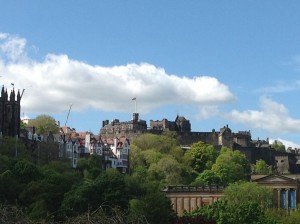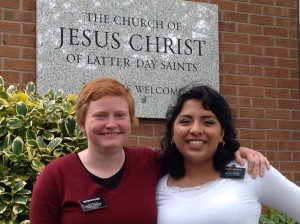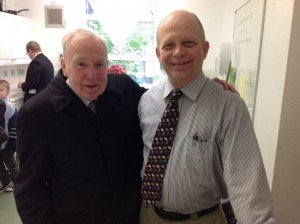 This past week my family traveled to Edinburgh, Scotland, to spend time with my husband’s father, who was born and raised in Edinburgh. Though we hope to have many more years associating with “Brother Stout,” he is in his eighties now. So with camera and tape record in hand, we toured the tenements where his people lived, the fields in which he would play as a boy, calling up to his Mum for “a piece” with jam or cheese, and the illustrious prep school where a scholarship allowed him to attend classes past age 14.[ref]This prep school was George Heriot’s School, formed in 1628, and believed to be the institution on which J. K. Rowling modeled her fictional Hogwart’s School of Witchcraft and Wizardry.[/ref]
This past week my family traveled to Edinburgh, Scotland, to spend time with my husband’s father, who was born and raised in Edinburgh. Though we hope to have many more years associating with “Brother Stout,” he is in his eighties now. So with camera and tape record in hand, we toured the tenements where his people lived, the fields in which he would play as a boy, calling up to his Mum for “a piece” with jam or cheese, and the illustrious prep school where a scholarship allowed him to attend classes past age 14.[ref]This prep school was George Heriot’s School, formed in 1628, and believed to be the institution on which J. K. Rowling modeled her fictional Hogwart’s School of Witchcraft and Wizardry.[/ref]
In addition to these spots of interest primarily to the family, we toured the rest of the city – a delight for various reasons, providing insight into both general history and Mormon history.
One of the first things we did was attend church services in the Edinburgh Ward. I particularly enjoyed speaking with Sister Pitcher (Smithville, Utah) and Sister Montoya (Mexico City, Mexico). We were excited about the announced visit Elder Holland will be making to Edinburgh, broadcasting from that chapel to the UK/Scandinavia region in a few weeks. But Sister Pitcher was sad – this will be the second time she will be leaving a place right before Elder Holland will be speaking in person (the first time was his speaking in the MTC right after Sister Pitcher left…).
Talking to the various members, we also met Jimmy Thompson, who had been a Sunday School pupil to my daughter’s great-grandmother.
It’s a small world, this, where you attend meetings based on the internet and find someone who interacted with your departed ancestor. It was a reminder to me that those we interact with in Church may well be related to us in unknown ways.
Din Eidyn – the Fort on the Slope
Edinburgh (pronounced Ed’n burrow) is near the oldest known human presence in Scotland, dating to roughly 8500 B.C. near the oyster-rich waters sourth of the Firth of Forth. Once the region became sufficiently settled for attacks to be a problem, people took refuge on the ancient volcanic mountains further inland. One of these is now known as Arthur’s Seat, where Orson Pratt dedicated Scotland for the preaching of the gospel. Another is the ancient mountain on which Edinburgh Castle now sits – a basaltic and rocky prominence that protected the land to the west from glacial erosion, producing a sloping ridge leading from the valley up to the edge of the ancient volcano.
In 1072 a young woman took shelter in the Firth of Forth from a terrible storm in the North Sea. She was Margaret, eldest child of the now-dead heir to the English Crown.[ref]Note how I, focused on Margaret, neglect to mention her brother, Edgar, who had direct claim to the throne of England. Thus is history written to focus on what the writers care about, of necessity obscuring the people and events they are lest concerned about.[/ref] Margaret brought the practices of the then-modern Roman Catholic Church to the court of Scotland. Her husband (King Malcom III) built Dunfermiline Abbey for her. Her son David built a stone chapel in her memory, the oldest surviving building in Edinburgh, and also established Holyrood Abbey at the base of the slope (now also site of the palace of Queen Elizabeth II in Edinburgh). FWIW, Holyrood is pronounced like Hollywood, but with an “r” instead of the “w.”
Margaret had an enormous influence on Edinburgh, which means by extension that she had an enormous influence on England, as Edinburgh would evolve to become the pre-eminent center of learning in the world in the 1800s. You can’t walk the streets of Edinburgh without coming across the birthplace or school of some intellectual or social luminary – Hume, Alexander Graham Bell, Arthur Conan Doyle, Joseph Lister, John Knox, and King James.
Sanitation, Law, and Anatomy
Prior to the advent of in-home plumbing, a household in Edinburgh would only use 2 gallons of water a day, and that was for cooking. Waste was collected in two buckets – one with liquid waste, which would be carefully stored by the community and aged for various uses (dying cloth, cleaning clothes, flavoring ale) and one with solid waste, which would be tossed out into the narrow streets of the medieval city where household pigs would be set out under supervision to consume the waste, recycling it back into a useful form. Eventually Edinburgh passed the “Nastiness Act” which stipulated that waste could only be tossed out between 10 pm and 7 am. The person tossing the waste was supposed to call out “Gardez l’eau!” meaning ‘watch the water,’ which became corrupted to “Gardy Loo!”
As part of the schedule enforced by such things as raining solid waste and short winter hours, Edinburgh is even now a place that closes up at 5 pm, except for the pubs.
Margaret brought monogamy to Edinburgh (and thence to the English realm), but monogamy wasn’t always observed in fact. The most notorious case of polygamy in Edinburgh involved Deacon Brodie, a respected man who allegedly had two extra wives in the shadows. To support this excess of family responsibility, Brodie would go out under cover of night and burgle from those he did legitimate business with in daylight. When his crimes were discovered, Deacon Brodie was executed.
Of interest to Mormons, this polygamous tale of Deacon Brodie would have been recounted to Orson Pratt during his 1840-1841 mission to Europe. To understand the horror Brodie’s behavior inspired, it is useful to know that the story of Dr. Jekyll and Mr. Hyde is derived from the true history Deacon Brodie, a science-fiction midrash of actual history, if you will.
Edinburgh was home to the first medical university associated with a clinic. An understanding of the human body was required, but bodies were in short supply. This inspired a trade in bodies, with body snatchers raiding graveyards for newly-interred corpses to earn $45,000 (in 2015 dollars) doctors were willing t pay for a fresh corpse. Grieving families would hire guards to ensure their loved ones had a chance to rest in peace until decomposition had removed the risk of “resurrection” for medical purposes. Others would at least temporarily inter their dead in walled areas locked under iron grates, as the guards tended to be ineffective (e.g., often killed).
Two men, Burke and Hare, improved upon the gravedigger’s trade by murdering unknowns, thereby able to deliver freshly dead corpses to their customer, Dr. Knox. When discovered, Hare testified against Burke. Burke was executed, his body in turn delivered to the medical college for dissection, where it can still be observed.[ref]The case of Burke and Hare, like the case of Deacon Brodie, preceded Orson Pratt’s time in Edinburgh. I can see the possibility of a direct impact of the Deacon Brodie story on Orson’s later behavior, but am not sure how the graverobbers and murders supplying the medical college might be observed in Orson’s later development.[/ref]
Edinburgh is important to Mormonism as the birthplace of Arthur Conan Doyle, who in Edinburgh learned the techniques of observation he would incorporate into his fictional detective, Sherlock Holmes. Edinburgh provided a rich background of stories from which ACD could concoct gripping tales. But Sherlock Holmes’ initial success, and therefore the detective’s success as an enduring franchise, is based on the initial novel, set in the exotic realm of America’s outlaw territory, Utah, and a Mormon theocracy that trafficked in women, enforcing its will by means of murder. Thus Arthur Conan Doyle used the seamy tales of his native Edinburgh, slapped on a dash of “Mormon” paint, and thus launched one of the most beloved fictional characters of all time.[ref]This is similar to how J. K. Rowling took the structure of Edinburgh’s George Heriot Preparatory school with its four houses (Castle, Greyfriars, Raeburn, and Lauriston), added dashes of witchery, lost treasures, and social justice (each with a firm foundation in Edinburgh’s past) to come up with Harry Potter’s scholastic universe.[/ref]
Ultimately, however, what matters is not the cartoon of Mormonism conveyed in books and shows of those outside the faith. It is the individual faith and lives of those inside the faith that will ultimately matter. And that faith is captured by Jimmy Thompson and Sisters Pitcher and Montegna, among others. It is the faith of a devout Scottish mother who insisted the family relocate to Utah rather than Australia after the war, so her boys could find Mormon wives.





TheMillennialStar: Stories from Eidyn (Edinburgh) http://t.co/rLk7NexRwV #lds #mormon
Thanks for the write up Meg. It is certainly one of the most beautiful cities I’ve ever had the pleasure of visiting, the Athens of the North, still as vibrant today as it was during the Enlightenment.
https://nathanandwinona.wordpress.com/2015/02/27/wandering-the-royal-mile/
I’ve been there several times but your wonderful writeup provided me new insights. Thank you!
Edinburgh is NOT in England. It never has been. George Heriot’s is not a prep school (look up the definition of a prep school) and Fettes was the model for Hogwarts.
Thanks for the nice sketch of Edinburgh. I’d love to tour there some day.
Hi Oor Willie,
I never said Edinburgh was in England. Just that Margaret’s actions had a direct impact on England (as she was sister of the last male in the Wessex line and ancestor of the Plantagenet kings of England).
As for the inspiration for Hogwarts, one website talking about literary artists from Edinburgh says “Various locations across the city are said to have inspired [Rowling], including Fettes College and George Heriot’s School as influences on the spectacularly gothic Hogwarts Academy.” The Elephant Cafe where she initially wrote the books is near Heriots rather than Fettes. Because Heriots is specifically set up to take in fatherless children on scholarship and offer scholarships to brilliant but otherwise underprivileged youth, you would see in Heriots the kind of class tension between students that exists in Rowling’s fictional Hogwarts.
Fettes has embraced the idea that it is an inspiration for the books, holding special events to that effect. On the other hand, the wonderful administrator who led us around Heriots (Margaret Peat) indicates that she’s never bothered reading any of the books or watching the movies.
Heriots (founded 1628) is right next to the Grassmarket, which is the ancient locus of pubs in Ediburgh, much like the proximity of Hogwarts to Hogsmeade. Fettes is northeast of Newtown, and there is no such ancient and delightful villiage of this nature nearby.
The Grassmarket was where livestock was traded and sold since the past millennium (as in 1100 on) and was also the site of public executions, etc.
Fettes has nine houses in comparison to the four of Heriots. Fettes was founded in 1870 and follows the English system rather than the Scottish system.
On the other hand, Rowling was clearly inspired by far more than the one storied school that was closest to her physical location. But I still maintain that if you have to exalt one school as the main inspiration for Rowling’s Hogwarts, Heriots is a strong contender.
My family lived 10 miles from Edinburgh and my father was a professor there – and this was the first time I had come across the supposed Gallic etymological derivation of its name (which gets pronounced more like Edn-burra – it is, I am afraid, a characteristic ‘Americanism’ to emphasize the second part of the word as ‘burrow’).
Looking at Wikipedia http://en.wikipedia.org/wiki/Etymology_of_Edinburgh – see that modern scholarship has supposedly refuted the traditional and straightforward derivation of the name from Anglo-Saxon/ Old English as (King) Edwin’s Burgh/ Borough – http://en.wikipedia.org/wiki/Burgh#Etymology-
My interpretation is that the confident ‘Eidyn’ derivation is likely to be a fanciful bit of anti-English Celticism, driven the the ressentiment of modern nationalism!
Yes, -burgh is pronounced as one would pronounce -borough, and with the local accent, that comes out -burra.